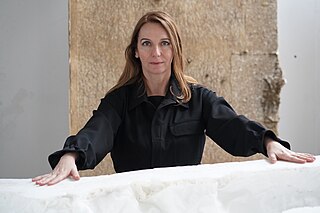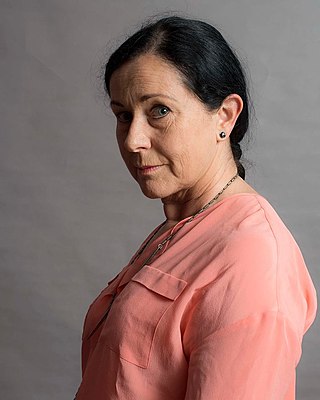Related Research Articles

Doris Dörrie is a German film director, producer and author.

Angela Bulloch, is a Canadian artist who often works with sound and installation; she is recognised as one of the Young British Artists. Bulloch lives and works in Berlin.

Fabrice Hybert, also known by the pseudonym Fabrice Hyber, is a French plastic artist born on 12 July 1961 in Luçon (Vendée). At 56, he was elected to the Academy of Fine Arts on April 25, 2018.

Pierre Bismuth is a French artist and filmmaker based in Brussels. His practice can be placed in the tradition of conceptual art and appropriation art. His work uses a variety of media and materials, including painting, sculpture, collage, video, architecture, performance, music, and film. He is best known for being among the authors of the story for Eternal Sunshine of the Spotless Mind (2004), for which he won the Academy Award for Best Original Screenplay alongside Michel Gondry and Charlie Kaufman. Bismuth made his directorial debut with the 2016 feature film Where is Rocky II?.

Ulrich Matthes is a German actor. He is best known for having played Joseph Goebbels in the 2004 film Downfall.
Éric Troncy is a French curator and art critic who works and lives in Dijon, France, he co-directs the Contemporary Art Museum, Le Consortium, in Dijon, Burgundy. He is co-founder and director of the contemporary art magazine Documents sur l'art (1992–2000) with Nicolas Bourriaud, and of Frog Magazine with Stephanie Moisdon.

Asta Gröting is a contemporary artist. She works in a variety of media like sculpture, performance, and video. In her work, Gröting “is conceptually and emotionally asking questions of the social body by taking something away from it and allowing this absence to do the talking.”
Saâdane Afif is a French conceptual artist.
Alex Cecchetti is an Italian artist, poet and choreographer based in Paris and London.
Jan Kopp is a German visual artist. He has lived in France since 1991.

Lucienne Peiry, born in Lausanne on 4 September 1961, holds a doctorate (PhD) in the history of art; she is a specialist in Outsider Art, an exhibition curator, a lecturer and the author of several publications. She gives lectures in both Switzerland and elsewhere in Europe, and has been teaching Outsider Art at the Swiss Federal Institute of Technology in Lausanne since 2010. Since 2016, she has also been teaching at the University of Lausanne
Clément Cogitore is a French contemporary artist and filmmaker. Combining film, video, installations and photographs, Cogitore questions the modalities of cohabitation between humankind and its own images and representations.
Elsa Werth is a French artist who lives and works in Paris.
Catherine Francblin is a French art critic, art historian, and independent curator.

Jennifer Flay is the director of the Fiac.
Martine Aballéa is a French-American artist born in 1950.
Camila Oliveira Fairclough is a Brazilian and British artist who lives in Paris.
Hsia-Fei Chang is Taiwanese artist. She currently lives and works in Paris.
Marinette Cueco was a French plastic artist. She was also known for her creations using plants and minerals.

The Fondation Pernod Ricard, is a foundation and art space open to the public in the 8th arrondissement of Paris, France, focused on young artists and emerging art.
References
- 1 2 Aubin, Charles (25 January 2021). "Attack of the Killer Grannies: Pauline Curnier Jardin — Mousse Magazine". www.moussemagazine.it. Archived from the original on 1 August 2021. Retrieved 11 September 2021.
- ↑ Ruthe, Ingeborg (13 April 2021). "Pauline Jardin: ritual and ecstasy". Berliner Zeitung. Archived from the original on 25 August 2021. Retrieved 25 August 2021.
- ↑ "Le Phare » Maeva Cunci". www.lephare-ccn.fr. Archived from the original on 9 September 2021. Retrieved 9 September 2021.
- ↑ Conversation with Pauline Curnier Jardin & Charles Aubin https://frenchculture.org/performing-arts/2881-interview-pauline-jardin-charles-aubin Archived 2021-08-01 at the Wayback Machine
- ↑ Institute, Dutch Art. "Home ~ Dutch Art Institute". dai. Archived from the original on 17 August 2021. Retrieved 25 August 2021.
- ↑ "IF I CAN'T DANCE". ificantdance.org. Archived from the original on 22 April 2021. Retrieved 24 August 2021.
- ↑ Institute, Dutch Art. "Sara Giannini". dai. Archived from the original on 1 August 2021. Retrieved 12 September 2021.
- ↑ Institute, Dutch Art. "2017-2018 COOP study group: OPERA CORRUPTION. On Tricks, Tricksters and Charms ~ Frederique Bergholtz, Pauline Curnier Jardin, Sara Giannini ~ Partner: If I Can't Dance, I Don't Want To Be Part Of Your Revolution". dai. Archived from the original on 6 May 2021. Retrieved 25 August 2021.
- ↑ Dreyer, Inga. "Exzess in Blut, Fett und Gold (neues deutschland)". www.nd-aktuell.de (in German). Retrieved 13 September 2021.
- ↑ "Grotta Profunda Approfundita de Pauline Curnier Jardin, au cœur du corps". www.troiscouleurs.fr (in French). Archived from the original on 12 September 2021. Retrieved 11 September 2021.
- ↑ "Bergen Assembly". bergenassembly.no. Archived from the original on 16 August 2021. Retrieved 11 September 2021.
- 1 2 "Preis der Nationalgalerie 2019 – Preis der Nationalgalerie". preisdernationalgalerie.de. Archived from the original on 1 August 2021. Retrieved 11 September 2021.
- ↑ Ruthe, Ingeborg (13 April 2021). "Pauline Jardin: ritual and ecstasy". Berliner Zeitung. Archived from the original on 25 August 2021. Retrieved 11 September 2021.
- ↑ Hamburger Bahnhof museum https://www.smb.museum/en/exhibitions/detail/pauline-curnier-jardin/ Archived 2021-08-01 at the Wayback Machine
- ↑ "Pauline Curnier Jardin wins NN Group Art Award 2018". www.nn-group.com. 7 February 2018. Archived from the original on 12 September 2021. Retrieved 11 September 2021.
- 1 2 "Archived copy". Archived from the original on 6 September 2021. Retrieved 11 September 2021.
{{cite web}}: CS1 maint: archived copy as title (link) - ↑ "Artistes Pauline Curnier Jardin". Fondation d'entreprise Pernod Ricard. Archived from the original on 6 September 2021. Retrieved 11 September 2021.
- ↑ "Preis der Nationalgalerie 2019 – Preis der Nationalgalerie". preisdernationalgalerie.de. Retrieved 13 September 2021.
- ↑ "Fat to Ashes, 2021 – Freunde der Nationalgalerie" (in German). Retrieved 20 September 2021.
- ↑ "FRAC-Artothèque Nouvelle-Aquitaine - Acquisitions récentes". fracartothequelimousin.fr.
- ↑ "Pauline Curnier Jardin". Pauline Curnier Jardin — Centraal Museum Utrecht.
- ↑ Pompidou, Musée national d’art moderne-Centre (8 September 2021). "Musée national d'art moderne – Centre Pompidou". Navigart.fr (in French). Retrieved 13 September 2021.
- ↑ "Centre Régional d'Art Contemporain à Sète - Centre Régional d'Art Contemporain OCCITANIE / Pyrénées-Méditerranée". crac.laregion.fr. Archived from the original on 16 November 2017. Retrieved 11 September 2021.
- ↑ "Pauline Curnier Jardin: WAITING FOR AGATHA, SEBASTIAN AND THE REST OF THE HOLY CHILDREN — UNFOLDING A FILMIC RESEARCH". indexfoundation.se. Archived from the original on 11 September 2021. Retrieved 11 September 2021.
- ↑ "I Still Send You A Lot Of Affection And I Kiss You Through My Denture – 1646". 1646 Experimental Art Space. Archived from the original on 20 January 2021. Retrieved 11 September 2021.
- ↑ van den Eijkel, Wouter (28 March 2019). "Pauline Curnier Jardin - I still send you a lot of affection and I kiss you through my dentures". galleryviewer.com. Archived from the original on 11 September 2021. Retrieved 11 September 2021.
- ↑ De La Fresnaye, Marie-Elisabeth (10 June 2019). "Parties sans éteindre la lumière… Fondation d'entreprise Ricard". 9 Lives Magazine (in French). Retrieved 14 September 2021.
- ↑ "Performance Sebastiano Blu | Pauline Curnier Jardin". Evenementen in Amsterdam. Archived from the original on 12 September 2021. Retrieved 11 September 2021.
- ↑ "Forside". Den Frie English. Archived from the original on 12 August 2021. Retrieved 11 September 2021.
- ↑ "Archived copy". Archived from the original on 9 June 2021. Retrieved 24 August 2021.
{{cite web}}: CS1 maint: archived copy as title (link) - ↑ "LE GRANIT, SCÈNE NATIONALE BELFORT | Association des Scènes Nationales". Archived from the original on 11 September 2021. Retrieved 11 September 2021.
- ↑ "THE SHOWER OF SISTER BONDAGE". www.edbprojects.com. Archived from the original on 12 September 2021. Retrieved 11 September 2021.
- ↑ Bécourt, Julien. "Saints, sang & stupre, le grotesque selon Pauline Curnier Jardin". Switch on paper (in French). Retrieved 14 September 2021.
- ↑ "Pauline Curnier Jardin, the Resurrection Plot - Performa 15". Archived from the original on 29 April 2020. Retrieved 11 September 2021.
- ↑ "Pioneer Works". Pioneer Works. Archived from the original on 6 September 2021. Retrieved 11 September 2021.
- ↑ "Performa 15". Archived from the original on 14 June 2021. Retrieved 11 September 2021.
- ↑ "Les Soirées Nomades". Fondation Cartier pour l'art contemporain (in French). Archived from the original on 12 September 2021. Retrieved 11 September 2021.
- ↑ "Karlsruhe: 22. Europäische Kulturtage 2014". www.karlsruhe.de. Archived from the original on 11 September 2021. Retrieved 11 September 2021.
- ↑ "List Projects: Pauline Curnier Jardin". MIT List Visual Arts Center. 10 April 2014. Retrieved 14 September 2021.
- ↑ Gennevilliers, Ville de. "Ecole municipale des beaux-arts / galerie Édouard-Manet". Ville de Gennevilliers. Archived from the original on 12 September 2021. Retrieved 12 September 2021.
- ↑ Bisshop, Ally (20 September 2013). "Opening // abc - art berlin contemporary highlights". Berlin Art Link. Archived from the original on 11 September 2021. Retrieved 11 September 2021.
- ↑ "Nomadic Night " Pauline Curnier Jardin et Rachel Garcia Crèche vivante"". Fondation Cartier pour l'art contemporain. Archived from the original on 11 September 2021. Retrieved 11 September 2021.
- ↑ "Accueil". frac île-de-france. Archived from the original on 28 June 2021. Retrieved 11 September 2021.